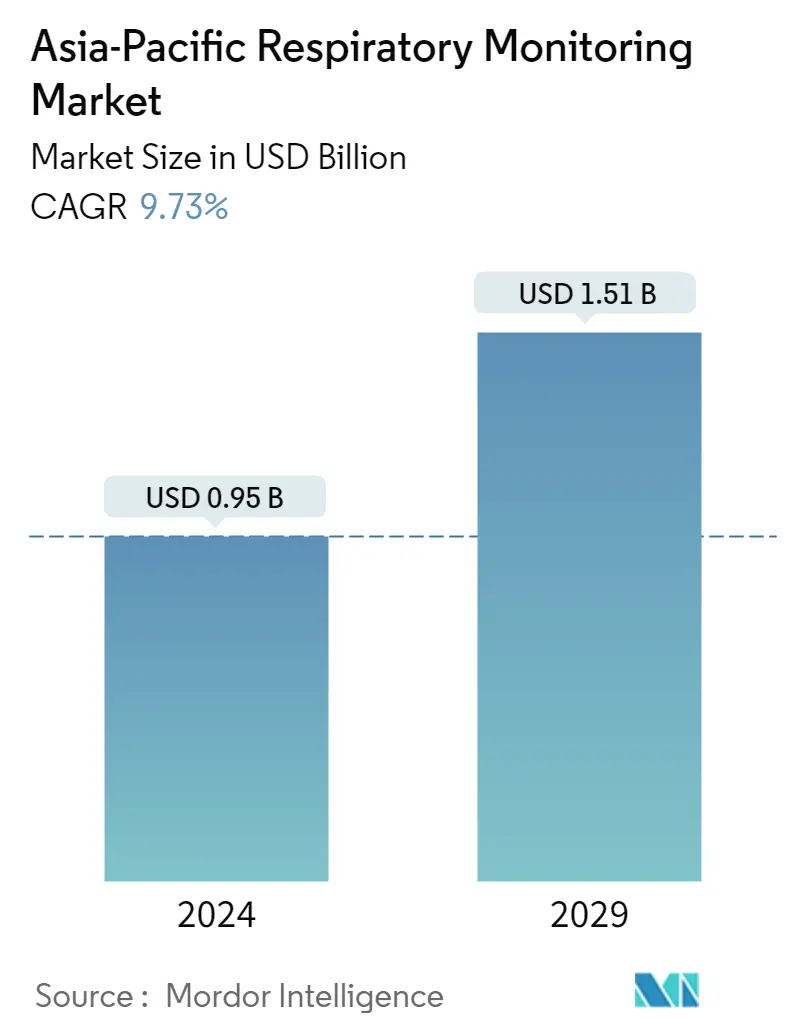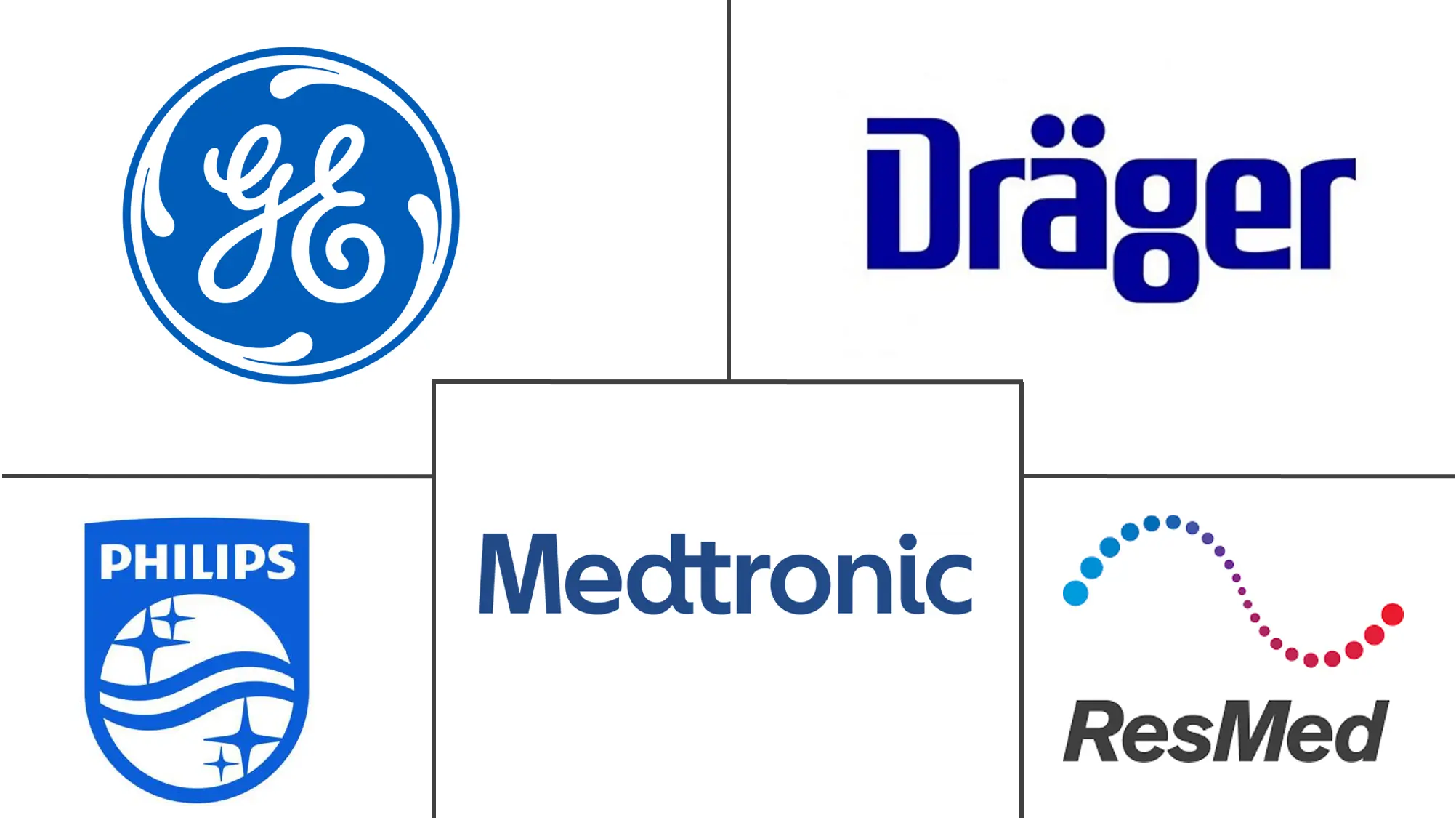Market Size of Asia-Pacific Respiratory Monitoring Industry

| Study Period | 2019 - 2029 |
| Base Year For Estimation | 2023 |
| Market Size (2024) | USD 0.95 Billion |
| Market Size (2029) | USD 1.51 Billion |
| CAGR (2024 - 2029) | 9.73 % |
| Market Concentration | Medium |
Major Players
*Disclaimer: Major Players sorted in no particular order |
Need a report that reflects how COVID-19 has impacted this market and its growth?
Asia-Pacific Respiratory Monitoring Market Analysis
The Asia-Pacific Respiratory Monitoring Market size is estimated at USD 0.95 billion in 2024, and is expected to reach USD 1.51 billion by 2029, growing at a CAGR of 9.73% during the forecast period (2024-2029).
- The COVID-19 pandemic had a significant impact on Asia-Pacific respiratory monitoring market. The pandemic unmasked the effect of health resource inequities and the lack of preparedness to upscale a coordinated response in many countries in the region. For instance, in May 2021, China exported over 15,000 patient monitors, to India, including respiratory monitors. Such a surge in demand drives the growth of the market.
- Additionally, as per the data published by the Australian Institute of Health and Welfare, in July 2022, the government spent USD 13.6 million through the National Partnership on COVID-19 Response (NPCR) to provide access to pulse oximeters to general practice and other healthcare settings to support the safe management of COVID-positive people. Hence, due to the surge in COVID-19 cases, the demand for respiratory monitoring devices increased, fuelling the market's growth. However, the market lost some traction as COVID-19 cases declined in the first three quarters, and the COVID-19 pandemic accelerated the use of respiratory devices. However, with the re-elevation of COVID-19 issues in China, the demand for respiratory monitoring is expected to create lucrative opportunities for the growth of the Asia-Pacific respiratory monitoring market in the studied period.
- The primary factors driving the market's growth include the high prevalence of respiratory diseases and growing pollution levels due to urbanization. For instance, according to the study published by the Journal of Infection and Chemotherapy in February 2022, respiratory syncytial virus (RSV) is one of the most common causes of lower respiratory tract infections in children of age five years and above in Japan and is associated with long-term respiratory morbidities such as recurrent wheezing and asthma, decreased lung function, and allergic sensitization. The respiratory syncytial virus imposes a significant burden on the Japanese healthcare system. Additionally, according to an article published in the International Journal of Chronic Obstructive Pulmonary Disease in October 2022, it was observed that 15.5 in 1,000 people were diagnosed with chronic obstructive pulmonary disease (COPD) annually in South Korea.
- In addition, as per the same source, the incidence rate of COPD was higher among men than women. Furthermore, according to a report published by the Global Asthma Network in 2022, asthma is one of the most common chronic diseases that affects about 262 million people globally, and it is a major cause of substantial burden of disease, including both premature death and reduced quality of life, in people of all ages in all parts of the world. Thus, the high prevalence of respiratory diseases, anticipated to increase the demand for different respiratory monitoring devices, which is expected to fuel the market growth over the forecast period.
- Additionally, the increasing initiatives such as product launches, acquisitions, and partnerships by market players in Asia-Pacific are also expected to contribute to the market's growth. For instance, in March 2021, Vyaire Medical launched the AioCare (HealthUp SA, Poland) mobile spirometry system in more than 15 countries, including Australia and others. This new technology allows physicians to promptly diagnose pulmonary diseases, including asthma and COPD, as accurately as hospital-grade spirometers. It performs high-quality patient monitoring via advanced digital connectivity at home. Such development is expected to drive the market's growth over the forecast period.
- Hence, as to the factors mentioned above, such as the high prevalence of respiratory diseases and growing pollution levels due to urbanization, Asia-Pacific respiratory monitoring market is anticipated to grow over the forecast period. However, reimbursement concerns and high costs associated with the devices will likely restrain the market growth.
